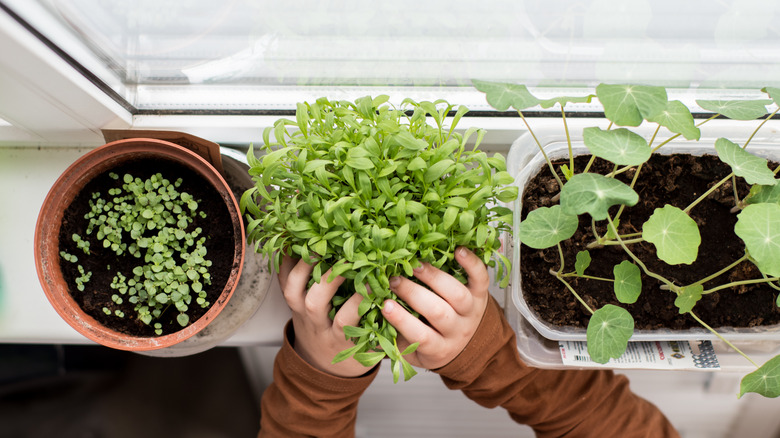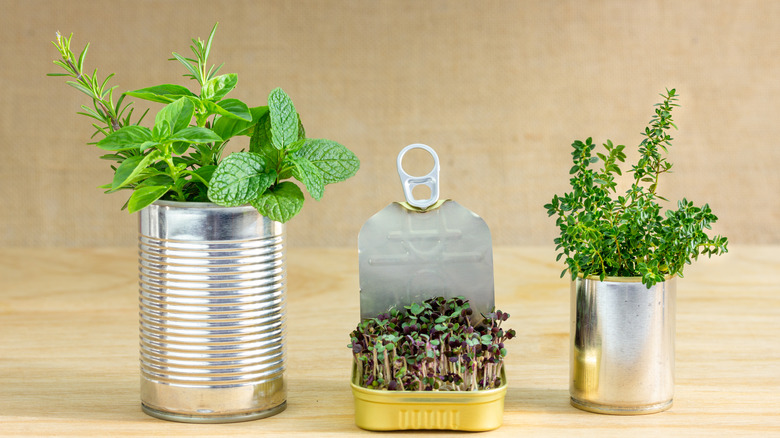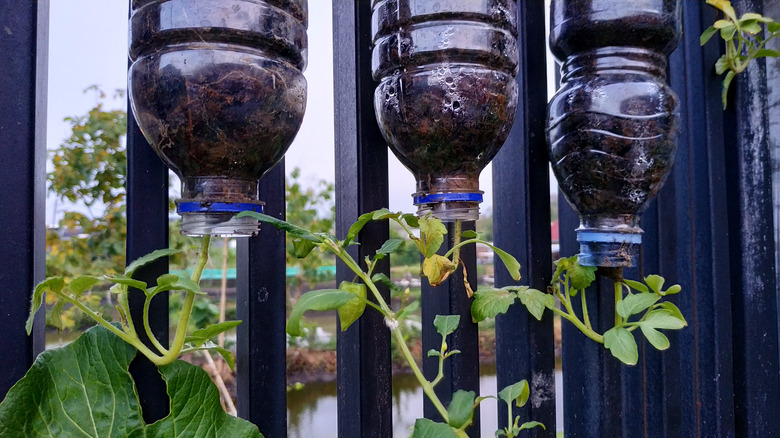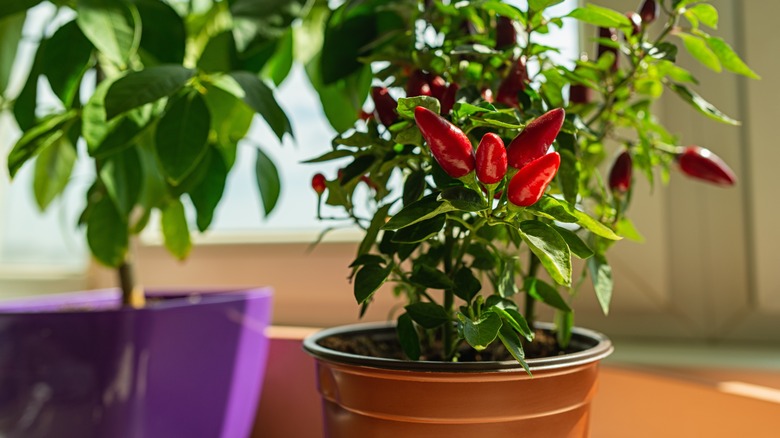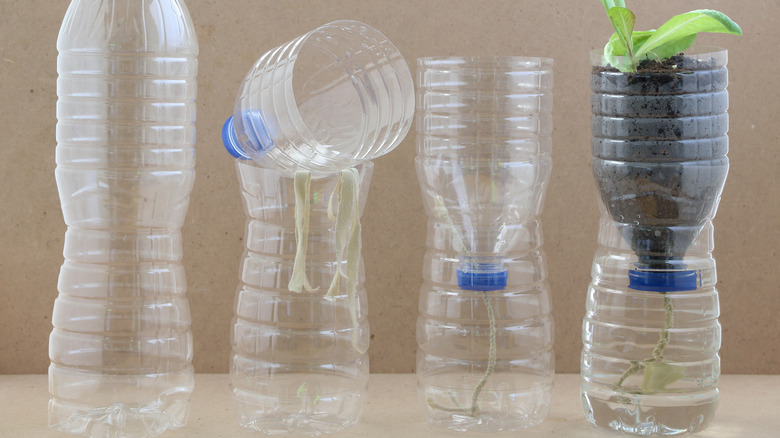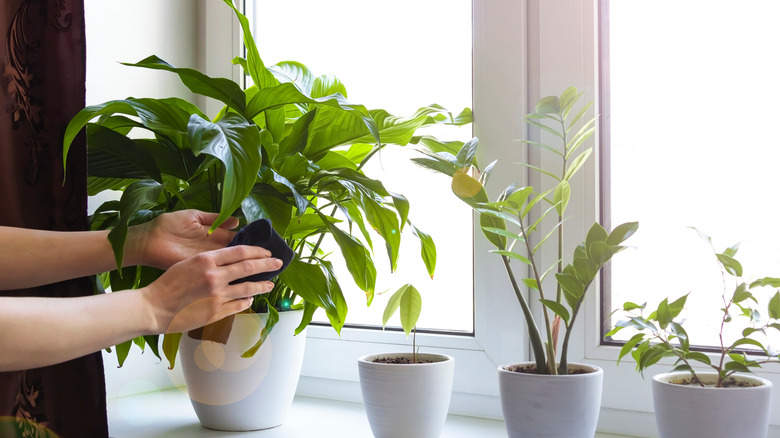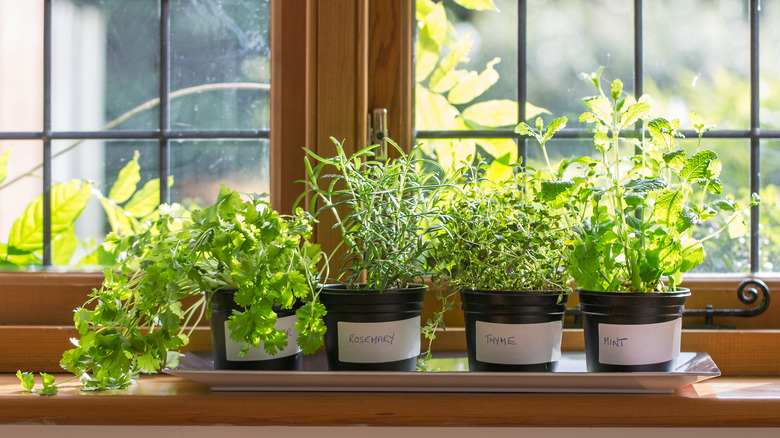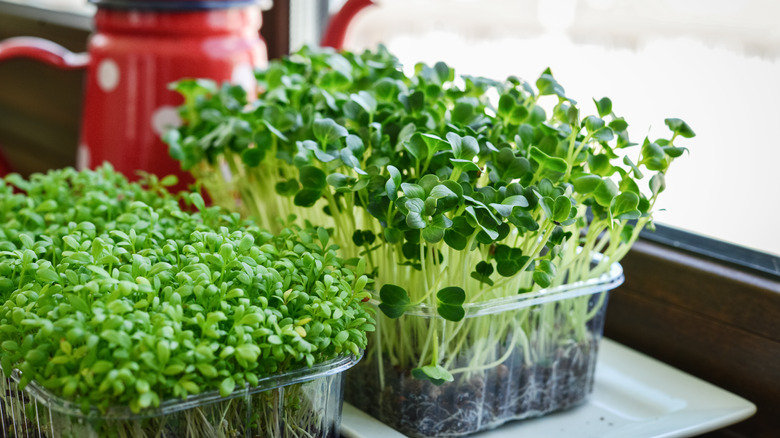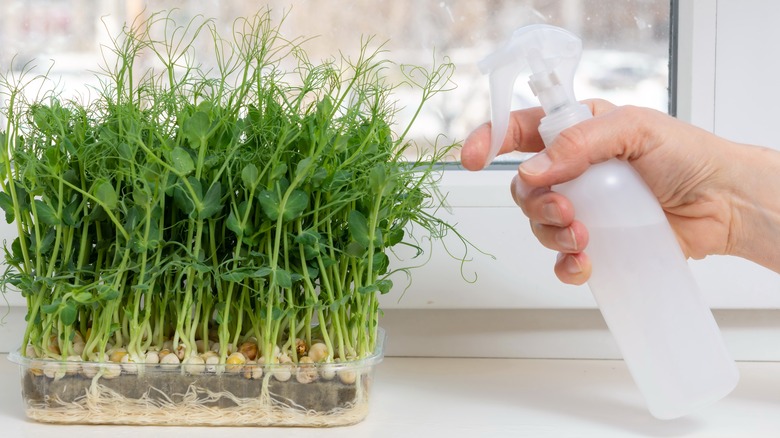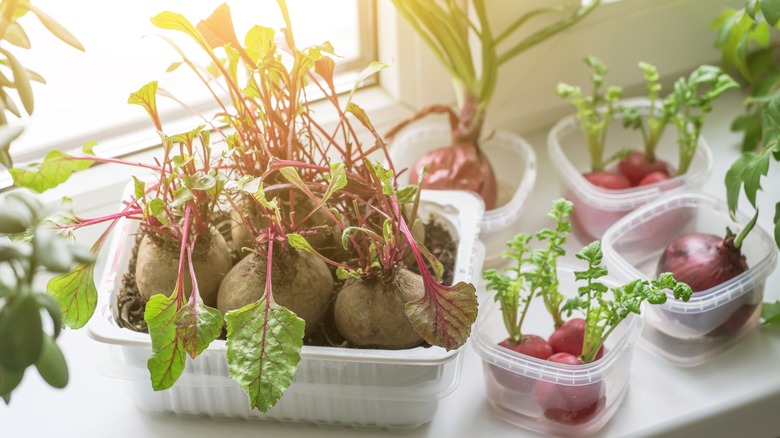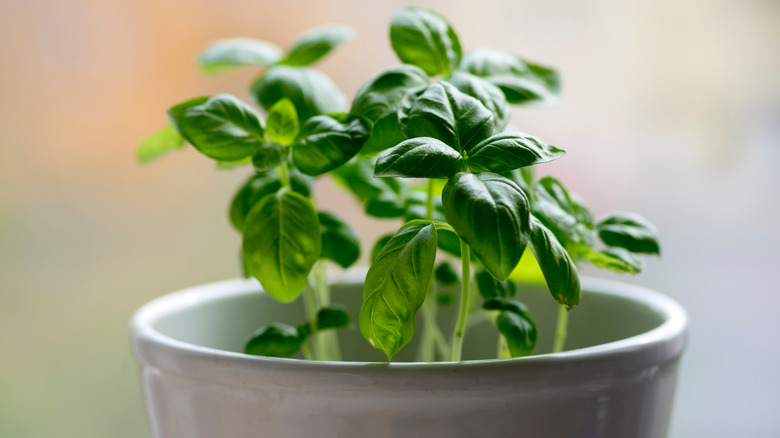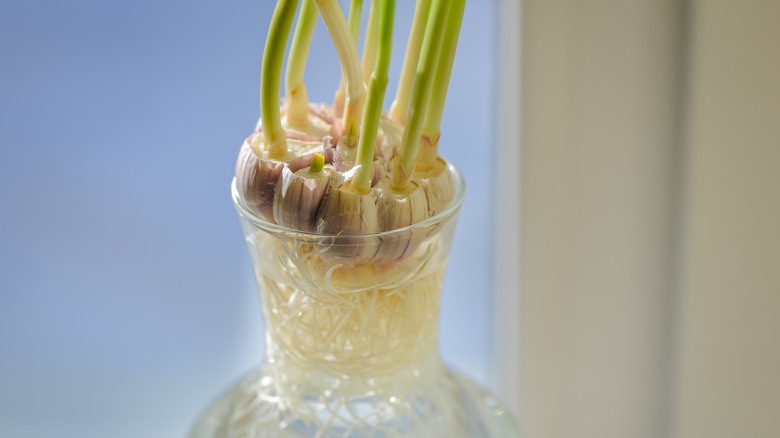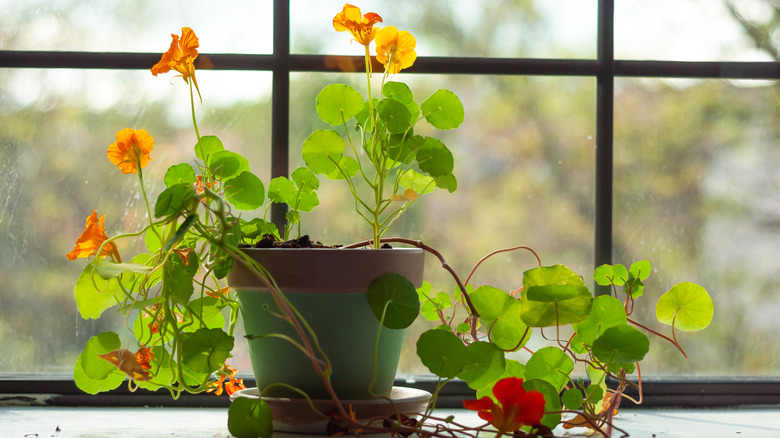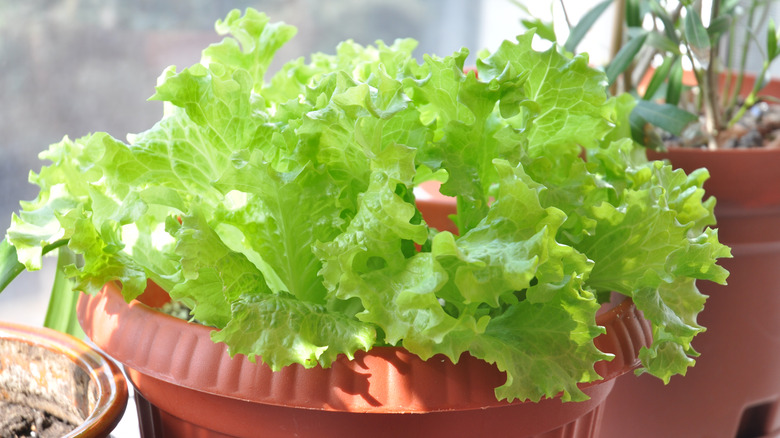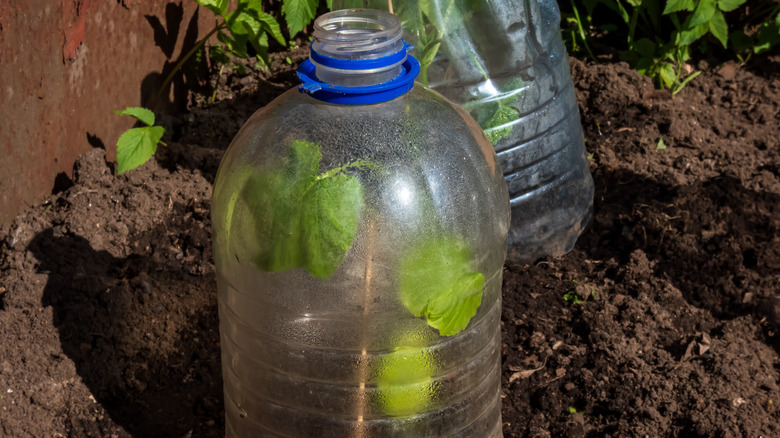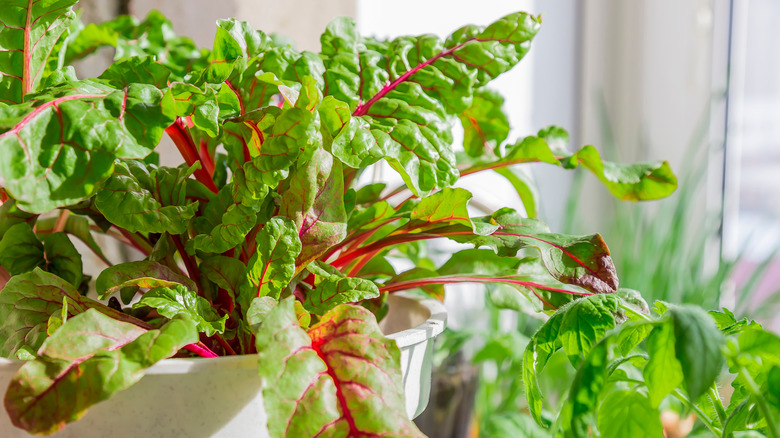Hacks To Grow Your Own Windowsill Veggies And Herbs
From pandemic lockdowns to economic restraint, many people are using their creativity, independence, and frugality to come up with some inspirational ideas when it comes to food. A wonderful idea that brightens up your life, as well as your kitchen, is watching your very own herbs and vegetables grow in front of your eyes on your windowsill. You don't need a big garden or even a courtyard, terrace, or balcony to enjoy the simple luxury of freshly grown produce (via 21Oak).
Vibrant colors, fresh fragrances, and delicious harvests await if you opt for your own windowsill planting. Start off by deciding which plants to grow, and plan how they'll fit on your windowsill. You may want to use your kitchen sill, but your main consideration is to pick the one that's the sunniest. Decide on whether to sow seeds or seedlings, and when to do so. Figure out which pots to use, choose the right potting soil, and learn how to look after your garden. You might want to begin with a few helpful hacks.
Make a tin can herb garden
Waste not, want not! A great way to upcycle your kitchen waste is to turn your used tin cans into herb pots for your kitchen garden. It's not all about practicality, either; it's about feeling good about a recycling project and also making your windowsill look great. You can use your home-grown herbs to make delicious herby recipes, such as cilantro lime rice. As well as being creative in the kitchen, you can express your imagination as you turn your tins into herb pots.
Clean your empty cans, whether they're tall creamed corn tins or small tinned sardine containers, after hopefully using them to make some great tin can dishes. If you're not so keen on the bare, chrome-look can, then you can give them a new look using some paint. You may want to decorate them so that they match the look and feel of your kitchen, or at least don't look out of place on your windowsill. A great tip is to use chalkboard paint so that you can write what herbs you're growing on the front in chalk and wipe clean and relabel if you change pots. Add some pebbles to your tins to help with drainage, so that you don't have to add any holes. Plant your seedlings and watch as your herb garden grows (via SWIISH).
Create an upside-down tomato planter
Don't let lack of outdoor space deter you from using your green fingers to create a vegetable garden. You can do so much more than grow some herbs in a pot if you only have a windowsill area. You can easily grow your own tomatoes with a helpful hack from The Secret Yumiverse. Your first task is to finish off a 2-liter bottle of soda, so that you can cut about an inch off the end of the bottle. You'll need a good, precision knife for this. Now you're set to create your upside-down tomato planter.
Add masking tape around the cut edge of the bottle, pierce with four holes, evenly spaced, and thread twine through these. You should now be able to hold up your bottle so it hangs straight down. Next, line it with foil, and get a tomato seeding that's wrapped in a kitchen towel and place it inside the bottle upside-down. The green part of your seeding needs to poke through the spout. All you need to do now is add some cotton balls with some potting soil on top that's not packed too tightly. Hang up your tomato planter in a sunny spot and water it. The foil will keep in the heat, while the balls will stop the water from leaking out. Once you've got your own tomatoes, why not make a delicious fresh tomato recipe, such as a quick tomato soup?
Use a mirror to boost the heat on chilis
Mirror, mirror on the wall, who's the hottest of them all? Hopefully, the answer will be your beautiful windowsill chilis that reflect your culinary garden skills. Attractive and colorful, chilis are not overly difficult to grow, but it's a good idea to follow a tip or two if you're trying to grow them successfully in a small space in your home. That's the advice from Sea Spring Seeds. A great hack to help your chilis along is a clever way to intensify the heat using a simple bit of beauty kit.
Chilis love the sun, so ideally you want to grow them on a sill that's on a south-facing window if you can. That's not to say that you have to use just one windowsill. What's great about windowsill gardens is that they're mobile, so feel free to move your chilis to the sunniest sill as the day progresses. Once you've planted the right chili, as in one that's suited to a small pot and is also the right level of heat, help it flourish by placing a mirror behind it. That way, the sunshine that hits the mirror's reflected back onto the plant, giving a real sunlight boost. Add to the sunny vibe by making a spicy Thai fried rice dish.
Leave your herb garden to water itself
While it might be a nice idea to lovingly tend to your windowsill garden at all times, busy lives mean sometimes you need a clever hack to help out. There's nothing smarter than a self-watering windowsill herb garden, so that your parsley, sage, and thyme don't dry up when you're not around, such as when you're away for a weekend. The Simple Things explains how you can water your pots when you're not at home.
Cut a plastic bottle into two, so that the spout end is shorter. Place this part inside the other, so that the bottle opening is facing down. In the space underneath the spout, in the bottom of the bottle, add some water. The water level can be filled up so that the neck is immersed in it. Depending on your know-how, you can use a glass bottle for this, but a plastic bottle will suffice, too. Get a piece of thick string and put it through a piece of mesh that can fit inside the inner bottle part. The mesh should sit at the base of the neck of the bottle. Tie a knot in the string so it doesn't fall through. You now have the string threaded through into the water. Plant your herbs in the inner bottle. The string will act as a wick, drawing up the water from the outer bottle to keep your herbs watered.
Clean your plants to keep them healthy during winter
If the idea of cleaning plants just sounds like the kind of potty advice from an overly house-proud tipster, perhaps you should reconsider. There's a reason to dust off your windowsill garden's leaves that's all about helping them get the nourishment they need from the sun. Hilton Carter, plant expert and author of "Wild Creations," reveals (via Homes & Gardens) why you need to clean your leaves, especially in the colder months. His belief is that plants should be cared for and treated as if they're part of your household, like a pet.
You'll need a soft cloth and some warm water to wipe the leaves. Make sure you clean both the top and the underside. For plants in the pots on your kitchen windowsill, you may have to add a mild liquid soap to the water if the leaves are sticky from cooking. Not only does this help deter plant pests, getting rid of dust like this allows the light to get through more easily to the leaves. In winter months, when the sunlight is weaker, this is ever more important. It can also help if your windowsill is not quite as sunny as you'd like.
Choose herbs that suit an indoor windowsill environment
You can work wonders with your windowsill garden creation, but you can't work miracles. What this means, is that part of the success of your pots is going to be based on what's in them. Not all herbs thrive indoors, for example, and some are hardier or simply thrive better on a sill. Choose the right seedlings to plant if you want to create your very own miniature herb-inspired Eden on your windowsill and look after them well is the advice of former senior garden editor for Martha Stewart, Todd Carr.
Most herbs need hours of sunlight, which is no surprise since many are from the Mediterranean. Along with plenty of sun, you also want to make sure they're well watered, and that the water can drain out the bottom. Keep in mind that you're using the right soil for herb pots too, such as organic, since you're going to be eating what you grow. Great herb choices include parsley, sage, rosemary, and thyme as they grow well in pots on a sill. Rosemary and oregano need soil that's drier, while cilantro and basil are good to pot because they're fast-growing. Bay leaves take a few months, while chives are a less space-consuming alternative to spring onions. Mint is robust and adds a lovely fragrance to your herb garden, as does lemongrass and lemon balm.
Growing cress is easy
Part of the joy of creating windowsill vegetables is the pleasure from making your garden grow. One of the easiest edibles to grow at home has to be cress. Simply add moist compost to a pot with a tray underneath, so it's 75% full. Add cress seeds and cover with plastic wrap for two days. Keep the soil damp and let the cress grow out of direct sunlight. Within a week, or when your cress is close to a couple of inches high, chop off your crop with a pair of scissors and enjoy your produce (via Express).
As highlighted in an SFGATE article, you can also grow cress shoots by adding seeds to a damp kitchen towel. Place the paper in a tray, and once you've scattered the seeds on top, press them down so that they can soak up some of the moisture. Cover with another kitchen towel and you should see your seeds start to sprout within a couple of days. You can then expose them to sunlight, keeping the initial towel moist by spraying it with water as it dries out. You'll be able to eat your cress within a couple of weeks and enjoy that distinct peppery flavor.
Plant dried peas and enjoy pea shoots
It's easy-peasy to grow pea shoots on your windowsill — they're such an appetizing microgreen to eat, too. A Facebook hack by "Grow Food For Free" author Huw Richards reveals that all you need is some dried peas, compost, and an empty ice-cream tub to grow snackable pea shoots on your sill. You can harvest them after just a couple of weeks. Besides including them in recipes, you can also eat them as you pass by, making them a perfect, on-hand microgreen snack.
Soak dried peas in water for a couple of hours. Next, get your tub and put holes in the bottom for drainage, or use a seed tray. In this, add an inch or so of compost. Scatter your soaked peas on top and cover with another layer of compost. Place the container into another container on the windowsill. Each day mist to keep moist and wait until the shoots appear. Once they're around two inches high they're ready to eat. Soak more dried peas and repeat to grow more munchable windowsill greens.
Beetroots flourish in a windowsill pot
Beetroots are just beautiful. Not only are they fabulously colored, they're good for you, and there are so many delicious recipes you can make with them — for instance, a savory roasted beet salad. It's not just herbs and vine-like plants such as tomatoes that you can grow on your windowsill. Beetroots can grow in a bunch with little space, too, and you can even eat the leaves.
Thames & Hudson features advice from Claire Ratinon, author of "How to Grow Your Dinner Without Leaving the House," on how to grow beets at home. You can plant beetroot seeds from spring into the summer, after being soaked for a day, with a couple of seeds close together to create a bunch of vegetables. Once your seeds have a couple of leaves you can transfer them to a larger pot, say around five quarts. Keep your pot well watered so the roots don't dry out, and get some sun on it. Liquid feed every couple of weeks helps, too. Within a couple of months, you can cook with the leaves as well as the roots, which should be at least the size of a golf ball but no bigger than a tennis ball. Twisting removes the bulbs that are big enough, leaving any smaller ones to grow up to size. Meanwhile, use the leaves in much the same way as you would spinach.
Thai basil loves low light
In the summer, it's easy to imagine your kitchen garden flourishing as sunlight bounces off every surface. However, as the days shorten, does that mean the end of your gardening delights? If might be that even in summer your kitchen doesn't get that light because your window isn't racing the right direction. The advice from a feature in The Saturday Evening Post is to grow herbs that thrive in low light — such as Thai basil.
Say you're wanting to rustle up a quick Thai green curry. You're going to need the distinct taste of Thai basil, which is not as easy to find in supermarkets as is Italian basil. Thai basil also differs from its European counterpart in that it quite likes the shade. To grow Thai basil, you first need to buy a fresh bunch. Place this in some water on your windowsill. What you're looking for are roots to sprout. Once they do, plant the Thai basil in a pot and watch it grow. Use the leaves to make Asian-inspired dishes. They have an anise flavor quite different than the sweetness of basil and the peppery taste of holy basil in Thai dishes (via The Culinary Compass).
Grow garlic greens in water
Garlic's used in so many dishes. You can really elevate recipes with garlic greens grown on your windowsill, and without any soil. Do you have a glass and a garlic bulb? If so, then you've got everything you need to grow your own garlic. That's right: While you may have a windowsill full of pots filled with potting soil, you can use hydroponics and grow your garlic in water. In fact, according to Hydrobuilder, this method is not only easy, but it creates a sustainable crop and healthier garlic due to the water being packed with nutrients.
To grow garlic greens, wrap a clove of unpeeled garlic in a damp kitchen towel. Keep this in a warm place for a couple of days. Once the clove has sprouted, put it in a small glass so that the green shoot faces upward, and fill the glass with water. You want only half of the sprouted part to be in water. That's it. Put your glass or jar on your kitchen windowsill, in a sunny position, as it needs lots of sunlight. Keep an eye on the garlic greens as they grow. Wilting is a sign they're possibly getting too much sun. When they have a good few inches of growth, snip off the greens, leaving two-thirds of them to continue growing. Use them straight away as a topping for a baked potato or in a pasta dish or stir-fry (via MasterClass).
Add color to your windowsill with edible flowers
Vertical Veg expert Mark Ridsdill Smith, author of "The Vertical Veg Guide to Container Gardening," offers some attractive windowsill garden hacks involving flowers (via The Guardian). His suggestion for making your windowsill look attractive and burst with color is to plant edible flowers. Incredible blooms that you can eat have to be the ultimate best-of-both-worlds plant for your sill, if you know what seeds to sow.
Feast on florals by planting nasturtium, with its bright orange petals and spicy taste. Easy to grow, the leaves are also edible, and you can eat the seeds pickled as an alternative to capers. Make pretty ice cubes by adding brilliantly blue borage flowers before you freeze. Add an orangey taste to salads and a golden yellow hue with marigold petals. Use gorgeous-looking chive flowers to add crunch and an onion flavor to dishes, while dazzlingly purple violas brighten up recipes. If you're already growing rosemary, sage, and cilantro, then you can also eat the flowers from these herbs, too.
Your lettuce is best grown in a shallow pot
As your windowsill herbs and veggies bloom in the warmer weather, make sure you've planted the ultimate summer vegetable, a lettuce, for salads galore. The great news is that it's also one of the easiest edible plants to grow. A good tip to success is to use a shallow pot, which still needs to be around 6-8 inches deep, according to Balcony Garden Web. Since the roots of lettuces don't grow deep, and the produce spreads out, you're best off using a wide pot with drainage holes.
While your lettuce may like some sun, too much heat is a killer, and you may want to offer some shade when it's really beating down. Water your lettuce regularly so that the soil is damp, but not waterlogged, as it will dry out quicker than some pots because of the lack of depth. When it comes to harvesting, use the leaves from the outer edge of the lettuce, making sure to leave an inch close to the crown. The important tip to remember is not to cut at the base level or below, otherwise your lettuce won't continue to grow after you've picked off the leaves. Because you don't have to use the whole lettuce at once, you can easily break off a few leaves to make your own salad as a side or as a light lunch dish.
Build your own indoor greenhouse with soda bottles
Simple and effective, a great hack presented by Container Gardening for growing seedlings is to create your own miniature greenhouse. If you're a budding windowsill horticulturist, then this tip will help save water and promote faster growth, with greater temperature and light control as well as protection. The great news is that all you need are some plastic soda bottles, so it's also a great way to add some environmentally friendly techniques into your gardening, too.
A seedling can be grown in the bottom half of a small bottle, with the top half removed completely. A few inches above the base make two holes on either side to create drainage. The potting soil and seedling are then grown in the bottle. To add a greenhouse effect, use a larger bottle, making a cut across around the 4-inch mark from the bottom. Follow the same procedure as above, adding your seedling and creating holes. The trick here is to not remove the top at all but simply be able to bend it back and forth. This way, you can easily get to the seedling while keeping it inside a bottle. Take the cap off or keep it on to change the humidity level within your makeshift greenhouse. Once your seedlings are all grown, transfer them to a pot.
Plant vegetables that grow up and down
Gardeners' World reports that when space is limited, a good tip for designing your windowsill garden is to plant vegetables that grow downward and crops that grow upward. That way they won't compete for space. Another good idea is to use dwarf varieties so that your garden bounty truly is in proportion. With so many herbs and vegetables that'll grow well on your sill, what you need to focus on is the combinations you grow.
Lettuce and radishes grow quickly, and you can fill any spaces as you eat your crop by planting more seedlings. Meanwhile, plant beans and peas that grow upward, as well as vegetables such as carrots which grow mainly under the soil. Spring onions are ideal to grow in soil between carrots, while edible flowers can be added to your garden to repel pests. Chives and marigolds, for example, can protect tomato plants. Chilis, onions, and herbs can grow comfortably together.
Create your herb and vegetable windowsill pots by learning how to sow seeds — and when — by using hacks to make your garden grow. Bountiful produce at your fingertips is not only about sustainability but can inspire recipe ideas. What better addition to your kitchen than it's very own culinary garden?
